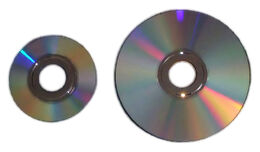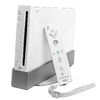 | |
| Media type | Read-only optical disc |
|---|---|
| Encoding | Digital |
| Capacity | GameCube: 1.5 GB Wii: 4.7 GB / 8.54 GB Wii U: 25 GB |
| Read mechanism | Laser |
| Developed by | Nintendo Panasonic |
| Dimensions | GCN: 8 cm (3.1 in) Wii/Wii U:12 cm (4.7 in) |
| Usage | GameCube Wii Wii U |
Nintendo optical discs are the optical disc format used to distribute video games released by Nintendo. This includes the GameCube Game Disc, Wii Optical Disc, and Wii U Optical Disc. The physical size of a GameCube Game Disc is that of a miniDVD, and the Wii and Wii U Optical Discs are the size of a DVD. GameCube discs can be used with the original version of the Wii and Wii Optical Discs can be used in the Wii U for backward compatibility. A burst cutting area is located at the inner ring of the disc surface.
In 2017, Nintendo dropped the disc-based media in favor of game cards for the Wii U's successor, the Nintendo Switch.
Format[]
<templatestyles src="Hlist/styles.css"></templatestyles><templatestyles src="Module:Sidebar/styles.css"></templatestyles>
| Optical discs |
|---|
| <templatestyles src="Hlist/styles.css"></templatestyles><templatestyles src="Module:Navbar/styles.css"></templatestyles> |

A section of the BCA of a Nintendo Optical Disc with two of the six additional cuts visible.
GameCube Game Disc[]
The GameCube Game Disc (DOL-006) is the game medium for the GameCube, created by Panasonic,[1] and later extended for use on the Wii through backward compatibility.[2] The GameCube Game Disc is a 1.5 GB,[3] 8 cm miniDVD based technology which reads at a constant angular velocity (CAV). It was chosen by Nintendo to prevent copyright infringement of its games,[4] to reduce cost[5][1] and by avoiding licensing fees to the DVD Forum. This also prevents the consoles from being used as general DVD players.[6][7]
Some GameCube games with large amounts of data span two discs, such as Resident Evil 4 and Enter the Matrix. Multi-platform games that fit on PlayStation 2 and Xbox DVD discs occasionally saw the removal of certain features in order to fit on GameCube Game Discs. Full-motion video scenes and audio are more compressed to fit on a single disc, reducing their quality. Prior to the GameCube, Nintendo consoles traditionally used cartridge-based media.
Wii Optical Disc[]
The Wii Optical Disc (RVL-006) is the physical game medium for the Wii, created by Panasonic. Nintendo extended its proprietary technology to use a full size 12 cm, 4.7/8.54 GB DVD-based disc, enabling it to have the benefits of the GameCube Game Disc, while having the standard capacity of a double-layer DVD-ROM. Although the Wii can use double-layer discs, all titles are single-layer prior to the release of Super Smash Bros. Brawl.[8][9] With the release of Super Smash Bros. Brawl, Nintendo admitted that some Wii systems may have trouble reading dual-layer discs due to a dirty laser lens.[9][10] Nintendo repaired systems with dual-layer problems,[9] and later released a disc cleaning kit for users to purchase.[11]
Wii U Optical Disc[]
The Wii U Optical Disc (WUP-006) is the retail physical game medium for the Wii U, with a capacity of 25 GB. The Wii U system software is backward compatible with Wii Optical Discs, but not with GameCube game discs.[12] The optical discs used for the Wii U differ in appearance from most other optical discs in that they have soft, rounded edges.[13]
The format was developed and supplied by Panasonic, which is one of the major patent holders in Blu-ray technology.[citation needed] It is not clear whether the Wii U Optical Disc is similar in physical design to the Blu-ray physical disc specification.[clarification needed] Nintendo president Satoru Iwata stated, "Wii U does not have DVD or Blu-ray playback capabilities. The reason for that is that we feel that enough people already have devices that are capable of playing DVDs and Blu-ray, such that it didn't warrant the cost involved to build that functionality into the Wii U console because of the patents related to those technologies", as, like with the GameCube and Wii optical discs, was chosen by Nintendo to prevent copyright infringement of its games, to reduce cost by avoiding licensing fees to the Blu-ray Disc Association (BDA) and to reduce loading times. This also prevents the console from being used as general Blu-ray players.[14]:3
Burst cutting area[]
Each Nintendo optical disc contains a burst cutting area (BCA) mark, a type of barcode that is written to the disc with a YAG laser. The data stored in this BCA mark includes an encrypted table related to the hardware-based copy-protection mechanics, in addition to 64 bytes of un-encrypted user-accessible data.[15]
A BCA mark is visible to the naked eye. It should not be confused with the IFPI mark that is on all optical discs. BCA is described in Annex K of the physical specification, and can be seen between radius 22.3±0.4 mm and 23.5±0.5 mm. There are also six additional evenly spaced small cuts just outside the BCA radius, which are related to the copy-protection used. These small cuts can clearly be seen if the disc is held in front of a strong light source.[15] The BCA mark lost some of its value as a copy protection mechanism upon being reverse engineered.[16]
See also[]
- GD-ROM
- Black Book (non-standard disc format)
References[]
- ↑ 1.0 1.1 "Dvd - Faq". Nintendo World Report. March 7, 2001. Retrieved July 6, 2011.<templatestyles src="Module:Citation/CS1/styles.css"></templatestyles>
- ↑ Casamassina, Matt (September 12, 2006). "IGNcube's Nintendo "Revolution" FAQ". IGN. Retrieved September 7, 2006.<templatestyles src="Module:Citation/CS1/styles.css"></templatestyles>
- ↑ "Nintendo GameCube Special Edition". Avrev.com. June 1, 2003. Retrieved July 6, 2011.<templatestyles src="Module:Citation/CS1/styles.css"></templatestyles>
- ↑ "Beginner's Guide: GameCube". GameSpy. July 30, 2003. Retrieved September 7, 2006.<templatestyles src="Module:Citation/CS1/styles.css"></templatestyles>
- ↑ Pian, Sharon (November 11, 2001). "Business & Technology | Let the games begin: The 3-way race is on | Seattle Times Newspaper". Community.seattletimes.nwsource.com. http://community.seattletimes.nwsource.com/archive/?date=20011111&slug=gamelaunch11. Retrieved July 6, 2011.
- ↑ "Play it again". Smh.com.au. September 13, 2003. http://www.smh.com.au/articles/2003/09/12/1063341761705.html. Retrieved July 6, 2011.
- ↑ "Wii U will not feature DVD playback - Everybody Plays - Nintendo Wii". Everybody Plays. Everybody Plays. Retrieved July 6, 2011.<templatestyles src="Module:Citation/CS1/styles.css"></templatestyles>
- ↑ "Review – Super Smash Bros. Brawl". SlashGear. Retrieved July 6, 2011.<templatestyles src="Module:Citation/CS1/styles.css"></templatestyles>
- ↑ 9.0 9.1 9.2 "Tobacco smoke makes Super Smash Bros Brawl unplayable on Wii". TG Daily. February 6, 2008. Retrieved July 6, 2011.<templatestyles src="Module:Citation/CS1/styles.css"></templatestyles>
- ↑ Scott Colbourne (March 20, 2008). "Not just a smash, a Super Smash". Toronto: The Globe and Mail. https://www.theglobeandmail.com/news/technology/article672298.ece. Retrieved July 6, 2011.
- ↑ Nintendo of America. "Repair Form for U.S. Residents". Nintendo of America. Archived from the original on March 10, 2008. Retrieved March 9, 2008.<templatestyles src="Module:Citation/CS1/styles.css"></templatestyles>
- ↑ Klepek, Patrick (June 8, 2011). "Wii U Does Not Play GameCube Games". Giant Bomb. Retrieved July 6, 2011.<templatestyles src="Module:Citation/CS1/styles.css"></templatestyles>
- ↑ Gilbert, Ben (November 12, 2012). "Take a very, very close look at the round-edged Wii U proprietary discs". Engadget. Retrieved November 18, 2012.<templatestyles src="Module:Citation/CS1/styles.css"></templatestyles>
- ↑ "2011 E3 Expo Analyst Q & A Session". Nintendo. June 8, 2011. Retrieved July 1, 2014.<templatestyles src="Module:Citation/CS1/styles.css"></templatestyles>
- ↑ 15.0 15.1 "» Anatomy of an Optical Medium Authentication (Part 1)". debugmode. Retrieved May 21, 2013.<templatestyles src="Module:Citation/CS1/styles.css"></templatestyles>
- ↑ Benchoff, Brian. "How One Company Cracked The Gamecube Disc Protection". hackaday. Retrieved 16 May 2019.<templatestyles src="Module:Citation/CS1/styles.css"></templatestyles>
External links[]
GameCube 
| ||
|---|---|---|
| Accessories | Controller (WaveBird • Smash Box) • Game Boy Player • Game Boy Advance link cable • Panasonic Q | |
| Related | List of games • Technical specifications • Online functionality • Dolphin | |
Wii 
| ||
|---|---|---|
| Hardware | Remote (MotionPlus • Classic Controller • Zapper) • Balance Board • Speak • Wi-Fi USB Connector • GameCube controller (WaveBird) • Broadway | |
| Software and services |
System software • Nintendo Wi-Fi Connection (connector • games) • WiiConnect24 (games) • Nintendo Week | |
| Third-party | Third-party accessories (Nyko Kama • Nyko Wand) • DarwiinRemote • Dolphin • Freeloader | |
| Wii Menu | Check Mii Out Channel • Everybody Votes Channel • Internet Channel • Nintendo Channel • Wii no Ma • Wii Shop Channel | |
| Games | Main | Best-selling • MotionPlus • Balance Board • Traditional control schemes • Nintendo Selects • Touch! Generations • Wii U eShop |
| Virtual Console | Japan • North America • PAL region • South Korea | |
| Backward compatibility | GameCube games (New Play Control!) | |
| WiiWare | Games (North America • PAL region) | |
| Wii series | Sports • Sports Resort • Play • Play: Motion • Fit • Fit Plus • Chess • Music • Party | |
| Related | Launch • Sales | |

